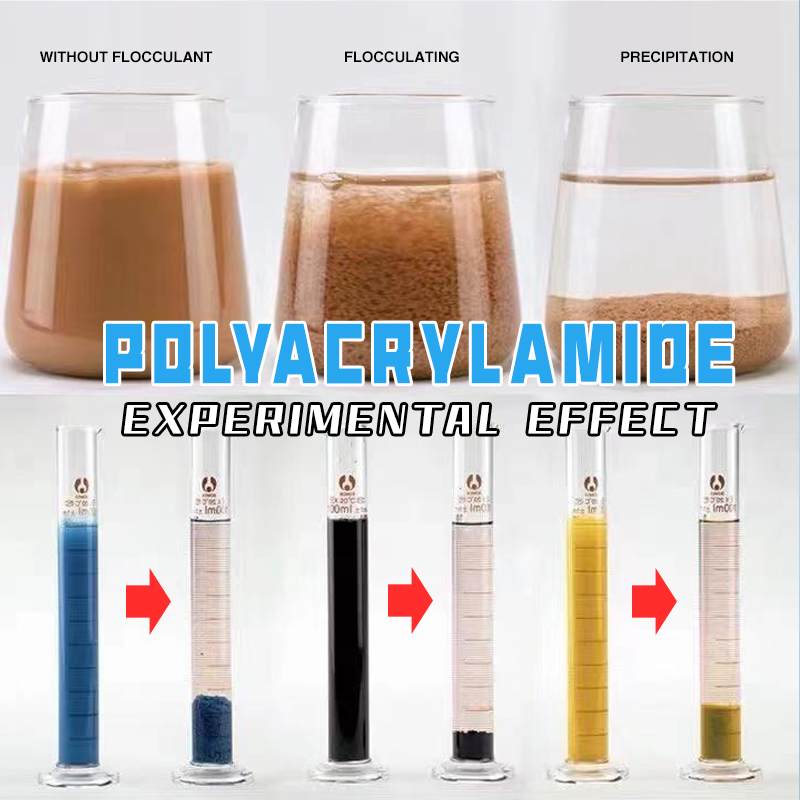Polyacrylamide can be divided into “anionic, cationic and nonionic polyacrylamide” according to its ionic properties, but the properties of high molecular organic polymers can be divided into anionic and cationic.
Although both cationic polyacrylamide and anionic polyacrylamide are used as flocculants in sewage treatment, they are different in effect and principle.
What is the difference between the anion and cation of polyacrylamide? In which respects are they distinguished?
Ⅰ. The Appearance Difference
Both anionic and cationic polyacrylamides have white particles and emulsions. Usually, the naked eye can hardly distinguish the white particles, but the emulsion is different, the anionic emulsion is white, and the cationic emulsion is light blue.
Ⅱ. Molecular Weight Difference
- The molecular weight of anions ranges from 4 million to 18 million;
- The molecular weight of cations ranges from 8 million to 20 million.
Ⅲ. Indicators Differences
- Molecular weight and degree of hydrolysis are the main indicators of anionic polyacrylamide;
- Ionicity and molecular weight are the main indicators of cationic polyacrylamide.
Ⅳ. Price Difference
The price of anionic polyacrylamide is lower than that of cationic polyacrylamide, and the higher the molecular weight, the higher the price.
Ⅴ. Application Differences
- Application of anionic polyacrylamide
(1) It is mainly used as a flocculant: for suspended particles, they are thicker and have a higher concentration of charged particles, and the pH value of the water is neutral or alkaline sewage, because the anionic polyacryloyl molecular chain contains a certain amount of polarity The function is to adsorb the solid particles suspended in the water, so that the bridge between the particles forms a large flocculant. Therefore, it can accelerate the settling of particles in the suspension, and has a very obvious effect of quick solution clarification and promotion of filtration. This product is mainly used for the treatment of chemical wastewater, waste liquid treatment and other inorganic wastewater; municipal sewage treatment, tap water industry, high turbidity water purification, clarification, coal washing, mineral processing, metallurgy, iron and steel industry, zinc, aluminum processing, electronics industry and other water deal with.
(2) Anionic polyacrylamide is used in petroleum industry, oil recovery, drilling mud, waste mud treatment, waterproof, reducing frictional resistance, improving oil recovery, and tertiary oil recovery.
(3) Used as a textile sizing agent, the performance of the slurry is stable, the slumping is less, the fabric breakage rate is low, and the fabric surface is smooth.
(4) Used in the paper industry, one is to improve the retention rate of fillers, pigments, etc. In order to reduce the loss of raw materials and environmental pollution; second, to improve the strength of paper (including dry strength and wet strength). In addition, the use of PAM can also improve the tear resistance and porosity of the paper, thereby improving the visual and printing performance of food and tea packaging paper.
(5) As a kind of adhesive, it can be used in the process of making incense, which has beautiful appearance and high strength.
- Application of cationic polyacrylamide
Both acidic and alkaline media are positively charged, usually lower than the molecular weight of anionic or nonionic polyacrylamide. Neutralization mainly obtains the performance of clarifying sewage. The main function of the flocculant is to flocculate with a negative charge, and has the functions of removing turbidity and decolorization. The effect of cationic polyacrylamide in the treatment of organic wastewater in alcohol, monosodium glutamate, sugar, beverages, printing and dyeing urban sewage, etc. is several times or dozens of times that of anionic polyacrylamide, nonionic polyacrylamide or inorganic salts, because this Wastewater generally has a negative charge. Cationic polyacrylamide is suitable for special sludge dewatering machinery such as high-speed centrifuges, belt filter presses, and plate and frame filter presses. It has the characteristics of fast floc formation, thick flocs, extrusion resistance, good shear resistance, and easy separation from filter cloth. Therefore, the dehydration rate is high, the liquid content of the filter cake is low, and the dosage is small, which can greatly reduce the user’s use cost. It can also be used for liquids such as hydrochloric acid and medium-concentration sulfuric acid to separate and purify suspended substances.

